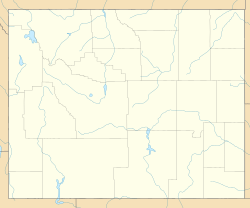The Big Hollow is a wind eroded deflation basin located to the west of Laramie, Wyoming in the United States. It is the second largest wind eroded depression in the world.[1] The Big Hollow is the largest deflation basin in North America. The Big Hollow is younger than the alluvial valley floors which now form its boundaries and is therefore of Late Pleistocene age (less than 250,000 years). During most of the Pleistocene the Big Hollow was actually a hill composed of soft sedimentary bedrock. The material making up this former hill was much more easily eroded than the alluvial valley floors which bounded it to both the north and south. Eventually, the hill was washed and blown away and then the wind continued to erode a deflation basin into the soft bedrock. Eventually the former hill became lower than the river channels which once flowed around it. The geologists call this "topographic reversal". The Qattara Depression near Cairo, Egypt is the largest.[2] The Big Hollow is an undrained basin and is 11 miles (18 km) long, 4 miles (6.4 km) wide, and up to 200 feet (61 m) deep.[3] Oil was discovered in 1917 and the basin has been productive since.[4] The basin is listed on the National Natural Landmark list.
| The Big Hollow | |
|---|---|
Map of Wyoming | |
| Location | South-east Wyoming |
| Nearest city | Laramie |
| Coordinates | 41°18′48″N 105°43′17″W / 41.31321°N 105.72131°W |
| Designated | 1980 |
See also
editReferences
edit- ^ "Big Hollow". Geology of Wyoming.
Covering an area of 40 square mile, it is the largest deflation basin in North America and the second largest in the world.
- ^ "Qattara Depression – World's Largest 'Vanish' Land". Akademi Fantasia Travel.
- ^ Knight, Samuel (1990). Illustrated geologic history of the Medicine Bow Mountains. The Geological Survey of Wyoming.
- ^ Trumbull, L.W (1917). Petroleum Geology of Wyoming. G.G. Bovee.
External links
edit- Big Hollow National Natural Landmark, National Park Service
- The Big Hollow and the Power of Wind Erosion (video). Ashley Garrelts; David Keto. University of Wyoming Extension. October 20, 2014. Event occurs at 00:24. Archived from the original on 2021-12-15 – via YouTube.
{{cite AV media}}: CS1 maint: others in cite AV media (notes) (link)
